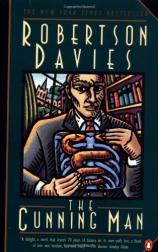About the Book
About the Book
The Cunning Man

One of the joys of Robertson Davies' fiction is its easy commerce with the full sweep of western culture from the ancient Greeks to the present. Another is its vigorous, talky characters, whose challenges, exhilarations, defeats, and ultimate destination are bodied forth in telling details. And a third is an old-fashioned, attention-grabbing theatricality. The Cunning Manis as broadly learned as its predecessors, as replete with vividly realized characters, and as dramatic in its presentation.
The declared subject of the novel (which shares several major figures and events with its immediate predecessor, Murther & Walking Spirits) is the cultural life of the city of Toronto in the years before and after World War II - or rather, that of the small area around St. Aidan's Church. Here "The Ladies" - the minor artist Miss Pansy Freake Todhunter and her friend the sculptor Emily Hart-Raven - resided and entertained the artistic community at their "Sundays." We learn about what happened through Miss Todhunter's letters to the sculptor Barbara Hepworth back in England, and through Dr. Jonathan Hullah, who is stirred to record his reminiscences by a young journalist, Esme Barron, who is herself bent on writing a series of articles about The Toronto That Used To Be. Miss Todhunter is especially good at conveying the peculiar mixture of accomplishment and parochialism that characterized the cultural life of the period.
Dr. Hullah, the story's chief narrator, takes the view that to understand a city's cultural past it is necessary to understand the people who created it. And so he tells the life stories of a number of the key figures, and provides capsule histories for many others. The life he explores most richly is his own. His account makes it entirely plausible that he should introduce many of the novel's learned references. He is comfortable with the thinking of Paracelsus, Thomas Browne, Robert Burton, and Sir William Osler, and refers easily to a wide range of novels and poetry. Without saying so directly, he makes it obvious that he himself has been a major contributor to The Toronto That Used To Be. So too was his old schoolfriend, Charlie Iredale, priest of St. Aidan's, passionate high Anglican and lover of its ritual and fine music. But Iredale's life had gone off the rails, and he was exiled to a minor parish, slid into alcoholism, and, after a brief period of reprieve, into death.
The Cunning Man is Davies' eleventh novel. In it he has drawn once again on his seemingly inexhaustible hoard of intuition, formidable memory, and astonishing erudition to produce a truly entertaining story.
The Cunning Man
- Publication Date: February 1, 1996
- Paperback: 480 pages
- Publisher: Penguin (Non-Classics)
- ISBN-10: 0140248307
- ISBN-13: 9780140248302

